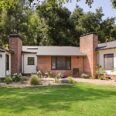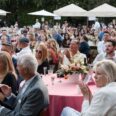
Perhaps you have never taken a moment to wonder whether a whale has a belly button. To Rob Phillips, Caltech’s Fred and Nancy Morris Professor of Biophysics, Biology, and Physics, it is exactly the kind of intellectual exercise that amplifies curiosity and leads to a new way of looking at the world.
This past winter term, Phillips taught a new class called, simply, The Whale (E100). The great mammals of the sea are fascinating and mysterious, Phillips says. They are a meeting point for researching not only biology and oceanography but language and culture, which whales have had for longer than humans. His course was designed to use the whale as a vehicle to understand how to think about the world, asking students to answer questions like, “Do [whales] have the genes responsible for producing enamel even though they lack teeth, if so, why?” and “Given that 3 million whales were removed from the oceans in the 20th century, how much less whale poop does that correspond to and how does it compare to the entirety of fertilizer in all the world’s farms?”
The Whale was a Sparks Short Course or “Spark,” a type of pass/fail course meant primarily but not exclusively for first-year undergraduates, which was introduced at the start of the academic year. The idea for Sparks courses—which are being championed by the provost’s office—is to give these undergraduates first-hand experience working with faculty members in a small group setting on a topic that is meant to ignite a spark of insight, creativity, or inspiration. In Phillips’ case, he used the whale not only as an intellectual springboard but also as an opportunity for students to get out of the lecture hall and into the world. To that end, Phillips took his Sparks class on a whale-watching tour in the waters off Long Beach. “Let’s actually bring the students to the frontier,” he says of the impetus for Sparks. “Let’s have a sense of adventure. Let’s talk about beautiful things in the natural world.”
Michelle Effros, Caltech’s vice provost and George Van Osdol Professor of Electrical Engineering, was one of the leaders in bringing the Sparks program to reality. “Our goal is to create the same kind of experience that led each faculty member to have the spark of excitement, or imagination, or engagement that led them to their own love for their discipline.”
In general, Caltech offers a variety of programs to help undergrads get experience with hands-on research. While the Institute’s 3:1 student–faculty ratio tends to lead to smaller class sizes, Effros notes that first-year students often find themselves in large classes that satisfy the core curriculum requirements for foundational STEM disciplines. As a result, they are not immediately able to delve into the fields of inquiry that they are specifically excited about. This is ultimately what led to the Sparks courses.
“The idea for the Sparks initiative came out of conversation with Carver Mead (BS ’57, PhD ‘60), an amazing member of the Caltech faculty who was also a Caltech undergraduate,” Effros says. “When he looks back on his experience in the core, Carver wishes that he had had more hands-on experiences. His excitement about creating that kind of experience for our students was the inspiration for these courses.”
Once the idea had been fleshed out, and following a call for proposals from the faculty, Caltech debuted the first two Sparks courses during the winter 2025 term. A second Spark was taught by Sterl Phinney (BS ’80), professor of theoretical astrophysics, who launched an offshoot of one of the classic courses he has been running for decades that teaches Caltech students how to think about doing science. That long-running Physics 101 class, Order-of-Magnitude Physics, challenges undergraduates to estimate the average rainfall or temperature on Earth not by taking measurements or consulting historical records, but by working out what these totals should be from basic principles of physics. This approach forces students to think at a deeper and more fundamental level about how research is done. Eventually, they use such an approach—extrapolating from first principles—to estimate quantities such as the speed of light.
When mulling over what would make a good Spark, Phinney had the idea to add even more of a hands-on element: Students would replicate classic science experiments, like those that led to the first ballpark estimates of Planck’s constant, the Boltzmann constant, and the radiation flux from the Sun. They would do so using only materials they could buy at Home Depot. “Not fancy lab equipment,” Phinney says, “but stuff from your kitchen and the local hardware store that can be used to try to estimate these constants not to 0.1%, but to 30%.”
“Let’s actually bring the students to the frontier. Let’s have a sense of adventure. Let’s talk about beautiful things in the natural world.”
This notion became a Sparks class called Crude Experiments. To Phinney, the class’s value lies not only in the chance for students to interact one on one with faculty and learn about what inspired them, but to understand the theory and thinking behind a research project. As undergraduates and even graduate students, much of the laboratory work available will involve completing parts of an already-established research project. It is rare, Phinney says, for these students to have the opportunity to develop the whole package: Come up with a research question, figure out how to address it, and, if it fails, figure out what went wrong and how to make it better.
Phinney’s Crude Experiments offering was meant to do just that. One student, Adele Basturk, decided to build a cloud chamber to detect cosmic rays. Because she is a pilot in the Aero Association of Caltech, she planned to conduct the experiment in her airplane and record measurements at 10,000 feet.
“As the only senior in the course, I am a bit of an anomaly,” Basturk says. “But after three years at Caltech, this course felt more like a revival of my curiosity. As an experimentally inclined physicist who adores the creativity involved in designing experiments, this course was perfect for the job.”
Phillips is teaching another Sparks course this spring: Counting (Badly and Brilliantly)! By focusing on efforts throughout scientific history, including diverse examples such as counting molecules or prime numbers, the class, like Phinney’s offering in the winter, asks its participants to deeply consider estimation and approximation.
“How many prime numbers are there less than N? How many prime numbers are less than a hundred, or a thousand, or a million? How do we think about that question?” Phillips says. “Because it really raises deep questions for thinking about math in ways that they’re not used to. A lot of people learn math at the level where there’s a thing called an equal sign, and two plus two is four, but there are many other kinds of equal signs in math.”
Whether or how many Sparks courses will be offered in future terms is not set in stone. But Effros’s hope is that more faculty members will be excited about introducing students to their scientific passions and will keep the program going.
“We had two Sparks offered in winter term, and each of them filled up on the day that registration opened,” she says. “So, the goal is to have enough Sparks to meet student demand. We hope that students and faculty will get really excited about these courses, and that the excitement for teaching these classes and the excitement for taking them will scale up together.”














 3 comments
3 comments



